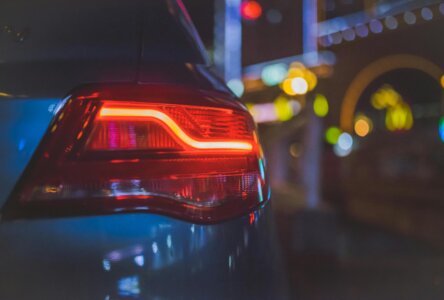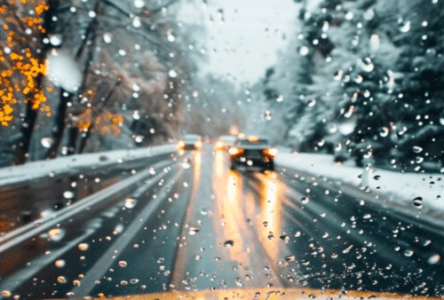Fender benders happen to even the most careful drivers. These minor collisions usually occur at low speeds—think parking lots, stop signs, or traffic jams.
While they might not seem overly serious at first, they can still cause hidden damage and lead to insurance claims.
Knowing what to do after you’ve been in a fender bender can help you stay safe, avoid common mistakes, and get your car repaired properly. That’s why we’re sharing expert advice on what to do after a fender bender. Keep reading so you can handle the situation with confidence.
Quick Fender Bender Checklist
Stay Safe
☑ Stop your vehicle, turn on hazard lights, and move to a safe spot.
☑ Check for injuries and call 911 if needed.
Assess & Document
☑ Check for visible damage and leaks. Call a tow if the car isn’t safe to drive.
☑ Exchange info: names, license plates, insurance details.
☑ Take photos of damage, location, and road conditions.
Report the Accident
☑ Call the police if injuries or major damage is involved.
☑ Notify your insurance provider with details and photos.
Get Repairs
☑ Visit a collision shop for bumper, paint, or frame damage.
☑ Find your nearest Craftsman Collision.
Need repairs? Schedule your appointment with Craftsman Collision today.
Safety First
Your first priority after getting into a fender bender is your safety. Here’s what you should do immediately:
- Stop your vehicle – Never drive away from an accident, no matter how minor.
- Turn on your hazard lights – This alerts other drivers to be cautious.
- Move to a safe spot – If the vehicles are drivable, pull over to the side of the road or into a parking lot.
- Check for injuries – If anyone is hurt, call 911 immediately. Even minor injuries should be checked by medical professionals.
- Watch for hazards – Look for leaking fluids or damaged electrical components that could pose a risk.
Assess the Damage
Once you’re in a safe spot, inspect both of the vehicles. There are a few specific things you should be looking for:
Dents and scratches
At first glance, small dents and surface scratches might not seem like a big deal, but they can weaken the vehicle’s exterior and lead to rust over time. In some cases, an impact can cause hidden damage beneath the surface, which can affect the alignment of the internal components.
Misaligned bumpers or panels
If your bumper or body panels don’t sit flush against the car anymore, there’s a chance the underlying frame absorbed some impact. Even slight misalignment can throw off your vehicle’s aerodynamics, compromise crash protection, and make future repairs more complicated.
Leaks under the car
A puddle forming under your car after a fender bender is a major red flag. Leaks can indicate damage to key systems like the radiator, transmission, or power steering. Driving with a fluid leak can also lead to overheating, brake failure, or transmission issues, so if you spot any, it’s best to call for a tow.
Headlight or taillight damage
Cracked or broken headlights and taillights might still function temporarily, but water and debris can seep inside and cause electrical failures over time. If a light is out or flickering after an accident, it’s a sign that internal wiring may be compromised, which could create a safety hazard at night or in poor weather conditions.
Even if your vehicle looks fine, some damage isn’t immediately visible. If you’re unsure, visiting a trusted collision repair shop like Craftsman Collision can help make sure your car is safe to drive.
When to Call for a Tow
If your vehicle isn’t safe to drive—if the airbags deployed, fluids are leaking, or parts are hanging off—call for a tow truck instead of driving away. If you have a CAA membership, this service is included, otherwise, call a tow truck service in your area.
Exchange Information Properly
To avoid any insurance headaches later, you need to make sure to exchange details with the other driver. Here’s the most important information to get:
- Full name and contact information
- Driver’s license number
- Vehicle make, model, and year
- License plate number
- Insurance provider and policy number
Document the Scene
Along with exchanging information with the other driver, it’s a good idea to take photos of the scene, including:
- The damage to both vehicles
- License plates
- Road conditions and traffic signs
- The surrounding area (e.g., intersections, skid marks)
Notify Your Insurance Provider
Reporting the accident to your insurance company is a very important step, even if the fender bender seems minor. Here’s what to do:
- Call your insurance provider as soon as possible.
- Provide all of the collected details, including photos and witness contact information.
- Describe the incident clearly, avoiding statements that could be interpreted as admitting fault.
- Ask about your coverage, deductible, and any next steps.
Common Mistakes to Avoid
Even in a minor accident, small missteps can create bigger headaches later. Avoid these common mistakes to protect yourself legally and deal with a smoother insurance process.
Admitting fault at the scene
It’s natural to want to apologize after an accident, but saying “I’m sorry” can be interpreted as admitting fault—even if you weren’t responsible. Instead, stick to the facts when speaking with the other driver, witnesses, and police. Let insurance adjusters and authorities determine responsibility based on the evidence.
Not reporting the accident within the required timeframe.
Every province has different rules on when and where to report an accident. Failing to notify the proper authorities or your insurance company on time can result in claim denials or even fines. Even if the damage seems minor, it’s better to report it immediately rather than risk complications later.
Forgetting to document damages and exchange information.
In the chaos of a fender bender, it’s easy to overlook some of the basics. But without photos, witness contact info, and a record of the other driver’s details, proving what happened can become difficult—especially if the other driver changes their story later. Always take clear photos of vehicle damage, license plates, road signs, and any skid marks or debris to support your claim.
When to Contact an Auto Body Shop
Even if your car seems fine after an accident, minor damage can hide bigger problems. Here’s when you should visit a collision repair shop:
- Paint damage – Scratches and chips can expose metal to rust.
- Bumper cracks or misalignment – Bumpers absorb impact, and any damage can weaken their protection.
- Frame damage – If your car pulls to one side or has uneven gaps between panels, your frame might be bent.
Why Prompt Repairs Matter
Delaying repairs can lead to:
- Rust and corrosion
- Higher repair costs later
- Safety issues if structural damage isn’t addressed
At Craftsman, we specialize in fender bender repairs, from bumper repair to frame straightening. Need expert repairs? Find your nearest Craftsman Collision.
Understand Your Legal Obligations
Every province in Canada has different rules for reporting car accidents, and understanding these requirements can save you from potential fines, insurance complications, or legal issues.
While a minor fender bender might not seem serious, failing to report it when required could lead to penalties. Here’s what you need to know based on where you live.
When Are You Legally Required to Report an Accident?
In Canada, whether or not you need to report a fender bender depends on the extent of the damage and whether injuries are involved.
Most provinces have a damage threshold, meaning if repairs exceed a certain dollar amount, the accident must be reported to authorities. And if someone is injured or a government vehicle is involved, a police report is usually mandatory.
- In British Columbia, there is no mandatory police reporting requirement for most accidents. However, if a police officer attends the scene of a collision that results in injury, death, or property damage exceeding $10,000, they are required to file a report. All accidents must still be reported to ICBC for claims processing.
- In Alberta, police reports are required for damage over $2,000 or if injuries are involved.
- In Saskatchewan, all crashes involving injury or death, hit and run, an impaired driver, an out-of-province vehicle or where a vehicle must be towed from the scene must be immediately reported to police.
This is why it’s always a good idea to keep a detailed record of the accident, including photos and written notes, for legal and insurance purposes.
Should You Report That Fender Bender?
If you’re unsure whether you need to report your accident, it’s better to err on the side of caution. Check your province’s laws, call your insurance provider, and document everything—this will ensure you’re covered if complications arise.
Tips to Prevent Fender Benders
Avoiding minor collisions (and major ones!) starts with good driving habits.
Avoid distractions
No texting, eating, or adjusting GPS while driving.
Keep a safe following distance
Tailgating increases the risk of rear-end collisions.
Check blind spots
Always shoulder-check before changing lanes.
Drive cautiously in bad weather
Rain, snow, and ice reduce traction.
If you’re trying to be extra cautious, taking a defensive driving course can also help lower your risk of accidents and could even reduce your insurance premiums. Learn more about safe driving from the CAA.
Common Myths About Fender Benders
Minor accidents don’t need to be reported.
Some drivers assume that if the damage is small, they don’t need to inform their insurance provider. But even a seemingly harmless fender bender should be reported. If the other driver decides to file a claim later—or exaggerates the damage—you could be left unprotected. Reporting the accident makes sure your side of the story is documented and prevents any surprise claims against you.
If there’s no visible damage, everything is fine.
Just because your car looks fine doesn’t mean it escaped unscathed. Internal damage like a misaligned frame, damaged suspension, or leaking fluids can go unnoticed until it causes a bigger (and more expensive) issue down the road. A professional inspection can catch these hidden problems before they compromise your vehicle’s performance.
Any repair shop will do.
Not all auto body shops are created equal. Some lack the specialized tools, training, or certifications needed for proper collision repair. Choosing a certified shop ensures your car is restored to manufacturer standards, protecting its safety, resale value, and warranty.
Why Choose Craftsman Collision for Repairs?
At Craftsman Collision, we’ve been Western Canada’s trusted collision repair experts for over 40 years. Here’s why drivers choose us:
- Expertise in fender bender repairs – We handle everything from minor dents to frame realignment.
- Lifetime guarantee on repairs – We stand by our work for as long as you own your vehicle.
- Certified technicians – Our team uses the latest technology to restore your car to pre-accident condition.
- Convenient locations – With shops across BC, Alberta, and Saskatchewan, help is always nearby.
Need repairs? Schedule your appointment with Craftsman Collision today.

